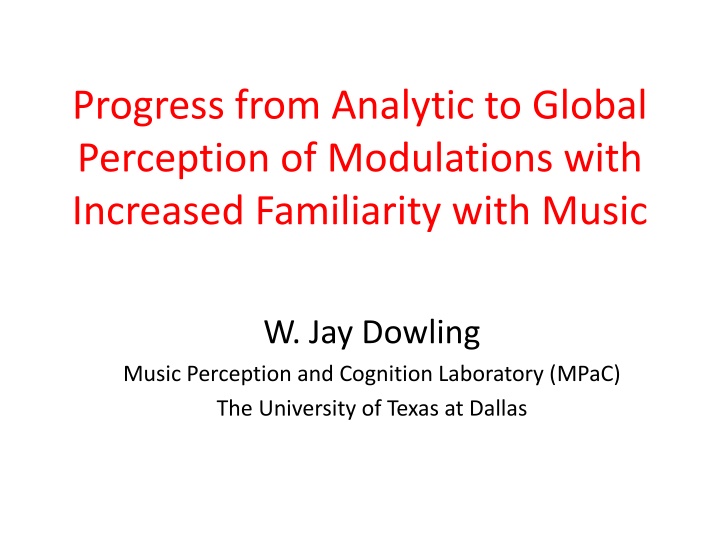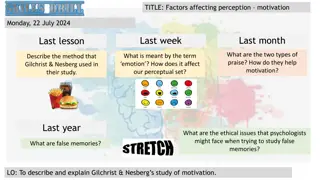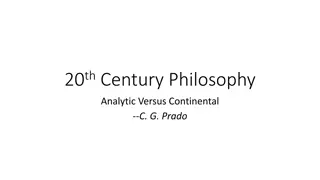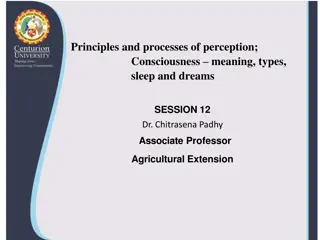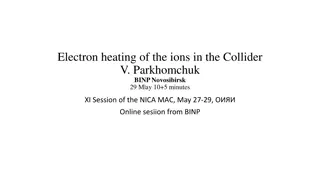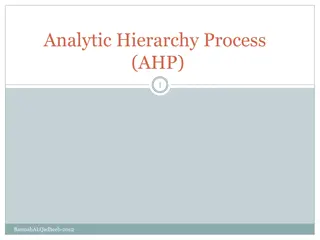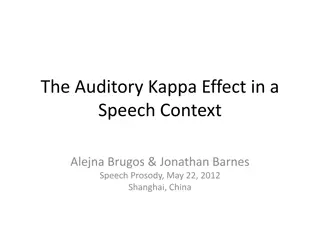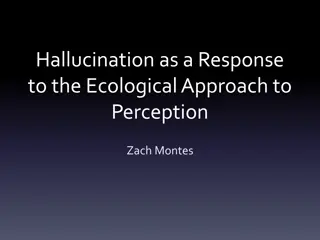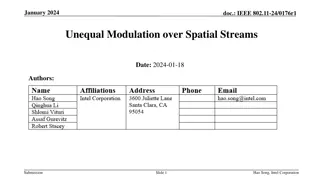Progress from Analytic to Global Perception of Modulations
Delve into the intricate world of tonal hierarchies and modulations in music perception. Explore the shift from a focused analysis to a holistic understanding of how familiarity shapes our perception. Unravel the essence of melodies within tonal frameworks, shedding light on the dynamic nature of musical interpretations.
Uploaded on Feb 15, 2025 | 2 Views
Download Presentation

Please find below an Image/Link to download the presentation.
The content on the website is provided AS IS for your information and personal use only. It may not be sold, licensed, or shared on other websites without obtaining consent from the author.If you encounter any issues during the download, it is possible that the publisher has removed the file from their server.
You are allowed to download the files provided on this website for personal or commercial use, subject to the condition that they are used lawfully. All files are the property of their respective owners.
The content on the website is provided AS IS for your information and personal use only. It may not be sold, licensed, or shared on other websites without obtaining consent from the author.
E N D
Presentation Transcript
Progress from Analytic to Global Perception of Modulations with Increased Familiarity with Music W. Jay Dowling Music Perception and Cognition Laboratory (MPaC) The University of Texas at Dallas
Tonal Hierarchy Provides a framework for encoding the pitches of a melody Selects 5-7 pitches out of the 12 semitones to form a scale Establishes a tonal center tonic pitch and a hierarchical pattern of importance of the other pitches This can be seen in tonal profiles that describe the hierarchies in different keys.
Two Western Tonal Hierarchies Krumhansl & Kessler (1982) Key profiles Notice in-scale vs. out-of-scale pitches RATING RATING PROBE TONE PROBE TONE 3
Melody and the Tonal Hierarchy The tonal hierarchy defines a set of expectancies Expectancies guided by general, schematic knowledge of the tonal system, and veridical knowledge of particular melodies (Bharucha) For example, out-of-key pitches in Schubert s Ave Maria note that they sound perfectly natural in a well-known melody Increasing familiarity with a piece develops expectancies such that formerly surprising events begin to sound natural and so are no longer sharply differentiated from their context
Modulation Modulation from one key to another involves replacing the tonal profile with a new one. This can involve: Changing the set of pitches (e.g., C major to C minor) Changing the tonal center (e.g., C major to A minor) or both (e.g., C major to A major) Modulation can take us to a closely related key that shares many pitches with the starting key (e.g., C major to G major), or to a distant key that doesn t (e.g., C major to B major) Close modulations often heard simply as variants of the original key (tonic-dominant)
Experiments Listeners hear a musical excerpt in one ear, along with a probe tone in the other ear (one of the 12 possible semitones) They rate the probe tone continually for how well it goes with the music (Toiviainen & Krumhansl, 2003) They go through the excerpt 12 times, each time with a different probe Different listeners hear the 12 probes in different orders, randomly determined
TASK 8
Experiments We use the ratings to put together tonal profiles that may change as the listener progresses through the piece We correlate those profiles with the standard profiles for the possible keys that the listener will encounter If the listener is following the modulations in their ratings, the correlations will show the shifts from key to key
Experiment 1 There are two kinds of modulation in Carn tic (South Indian classical) music: grahab dham (like C major to A minor), and r gam lik (like C major to C minor) We used one excerpt of each type, about 1 min long 10 Indian & 10 Western music teachers participated The Indian teachers were familiar with the excerpts, especially the r gam lik excerpt, whereas Western teachers were unfamiliar with both excerpts
Grahabdham (Raman & Dowling, 2016)
Results MANOVA: 2 Nationalities X 5 Time Periods There were main effects of time period for both modulation types: r gam lik , F(8,11) = 5.25, p<.01; grahab dham, F(8,11) = 8.57, p<.001. The Time Period X Nationality interaction approached significance overall for r gam lik , and was significant for the Sriranjani r gam in particular, F(4,15) = 4.60, p<.01.
Results For grahab dham, the Time Period X Nationality interaction was not significant overall (p<.18), but was significant for the individual ragams: Panthuvar li, F(4,15) = 5.22, p<.01; M hanam, F(4,15) = 6.47, p<.01. Clearly, the Indian teachers were responding in a more global fashion to the modulations than the Western teachers, who were more analytic. Could this global responding be due to their greater familiarity with the pieces?
Experiment 2 In Experiment 2, we were able to look at possible effects of increasing familiarity Since listeners heard the excerpts 12 times in the continuous probe-tone method, we could look at their responses during the first 3 hearings compared with the last 3 hearings The excerpts were the first 2 min of Haydn s Quartets op. 76, no. 2 ( Quinten ) and op. 76, no. 3 ( Emperor ), starting at the beginning and stopping at the end of the exposition section The excerpts contained 3 or 4 modulations: d minor, F major, f minor, F major C major, G major, g minor, Eb major, G major
Experiment 2 Blocks of 12 listeners with the same level of musical training complete a Latin square, so that for each trial each of the 12 probes is represented We will look at the responses of the 60 listeners with more than 5 years of musical training, and the 60 with no musical training We use the ratings to put together tonal profiles that (we hope) will change as the listener progresses through the piece We correlate those profiles with the standard profiles for the possible keys that the listener will encounter
76/2 Exp trials 1-3 d F f F
76/2 Exp trials 10-12 d F f F
76/2 Inexp trials 1-3 d F f F
76/2 Inexp trials 10-12 d F f F
76/3 Exp trials 1-3 C G g Eb G
76/3 Exp trials 10-12 C G g Eb G
76/3 Inexp trials 1-3 C G g Eb G
76/3 Inexp trials 10-12 C G g Eb G
Conclusions The more experienced listeners differentiated the changes of key more clearly With repeated exposure to the pieces, the sharp differentiation of keys tended to get smoothed out, suggesting that familiarity leads to a more global approach to hearing the piece
Experiment 3 This led us to manipulate familiarity even more strongly 12 student orchestra members performed the task with a piece they were going to learn, but had not seen yet (the finale of Dvorak s American String Quartet) Then they did the task in the middle of the semester after practicing the piece for 6 weeks Finally the did the task after playing the piece in their concert
Experiment 3 There were 5 modulations in the first 2 min of the piece, involving 4 keys: F major A minor C major Ab major We looked at sessions 1 and 3, where the difference in familiarity was strongest
Session-1 1 0.8 0.6 F 0.4 a C 0.2 Ab 0 1 2 3 4 5 6 7 8 9 10 -0.2 -0.4
Session-3 1 0.8 0.6 F 0.4 a C 0.2 Ab 0 1 2 3 4 5 6 7 8 9 10 -0.2 F a F C Ab F -0.4
Results ANOVA: 2 Sessions X 10 Time Periods X 4 Keys Strong Period X Key interaction, F(27,297) = 27.30, p<.0001 The only interaction involving session was Session X Key, F(3,33) = 2.39, p<.09, in which the key means were more spread out in Session 1 This could be taken as a very indirect indication of a global shift, but clearly these listeners started out and finished with quite sharp differentiation among keys
Conclusions In some cases there are indications of a tendency toward more global perception with increasing familiarity (Indian vs. Western differentiation of Indian modulations; loss of sharp differentiation throughout session by more experienced musicians) Less knowledgeable listeners tend to a more global pattern of response, correctly tracking the principal keys of an excerpt, but not always tracking shifts of key
Conclusions However, our attempt at manipulating familiarity with the orchestra members failed to show convincing evidence of a shift from analytic to global perception It may be that the demands of playing the piece helped maintain those listeners in their more analytic mode This might contrast with familiarity derived from listening, where expected deviations come to blend into their context, with a resulting more global perception of the piece
THANK YOU Kieth Gryder Kevin Herndon Jaicey Johnson Chris Lo Parisa Najafigol Bhavana Penmetsa Rachna Raman Ashwin Ramesh Franco Sabatini Alan-Michael Sonuyi William Stanford Naveen Subramanian David Tram Sahiti Yarakala 36
